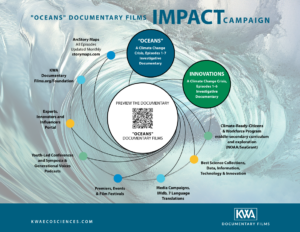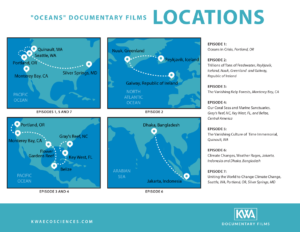
OCEANS: A Climate Crisis Series
Episodes
EPISODE 1
Oceans in Crisis — A look at the World Today, and How Climate Change is Threatening All Life on Earth Tomorrow. The Oceans Role in Everything Story.
EPISODE 2
The Physics of Weather and the Atmosphere on Earth — Extreme Weather—Hurricanes, Cyclones, Typhoons, Wildfires, Floods and Drought. The Life on Land – Driven by Water Story.
EPISODE 3
150-Billion Tons of Freshwater — It’s Hard to Chill Out When Your Icebergs and Glaciers are Melting. The Story of the A68A Iceberg and other Mega-Giants.
EPISODE 4
The Vanishing Kelp Forests of California and Other Coastlines of the World — The 95% Already-Lost Story of Whales, Urchins, Starfish and Sharks.
EPISODE 5
The Coral Seas and Marine Sanctuaries — Their Role in Climate, Coastal Protection and Ecosystem Survival. The 30% Already Gone and Going Story.
EPISODE 6
Jakarta is Moving — Biodiversity Under Threat. Indonesia’s Climate Change Adaptation and Mitigation Efforts. The One-Million Species Already Extinct Story.
EPISODE 7
The Vanishing Culture of Time Immemorial — The Story of Climate Change and its Effect on Indigenous Peoples in the Pacific Northwest. The Loss of All Sustainable Fisheries Story.
EPISODE 8
Weather Rages, Climate Changes — A look at the World Today, and How Climate Change is Threatening All Life on Earth Tomorrow. The Oceans Role in Everything Story.
EPISODE 9
Uniting the World To tackle Climate Change — The Ocean is Alive, Awake, and Unhappy. Two Billion People—Already on the Move. The Ultimate Mass Migration Story.
EPISODE 10
Superhuman Solutions — Technology, Innovation and Hero’s. Visionaries, and Generational Voices. The “Change Climate-Change” Story – Stepping up to the Challenge and Back from the Precipice.
In this inaugural and illuminating episode, we’ll dive into the heart of extreme weather phenomena, including hurricanes, cyclones, typhoons, wildfires, floods, and droughts, as we explore the intricate connections between the ocean and the atmosphere.
Join us on a journey into the icy heart of our planet as we witness the dramatic melt of colossal ice formations, including the awe-inspiring A68A iceberg and other colossal mega-giants.
In this episode of our documentary series, we embark on a journey to uncover the alarming disappearance of one of the world’s most biodiverse underwater ecosystems – the kelp forests of the US West Coast, and beyond.
In this episode we tell the 30% Already-Gone, and Going, story. We’ll descend into the depths of our oceans as we uncover the vital significance of coral reefs and marine sanctuaries in the fight against climate change. Through breathtaking visuals and expert insights, we reveal the ongoing narrative of the loss, and the immediate future, of these precious ecosystems at risk.
In this poignant documentary episode, we embark on a compelling journey to the heart of the Pacific Northwest, where the intertwined tales of climate change, sustainable fisheries, and indigenous cultures unfold.
In this gripping episode, we embark on a journey to explore the profound and far-reaching consequences of climate change in Southeast Asia.
As we bring the Ocean series to a close, we invite you on a deeply moving journey. From the tumultuous year of 1979 to the present day, the journey of climate change science and action has been a compelling and often bittersweet narrative.
This episode will focus on highlighting the anomalous “triple-dip” La Nina phenomenon and take us back to the origin of our spate of natural disasters and how the natural resources of the ocean and freshwaters in the Pacific Northwest, Canada, Alaska, and California are threatened.
The Oceans legacy does not end with Episode 7!
Its planned sequel: ‘Innovations’ is coupled with an ongoing ArcStory media and impact campaign, and a long-term commitment to a curriculum development, and an accelerator and incubator project supporting the next generation of scientists, engineers, policy makers and leaders. This will continue to drive real-world impact while offering investors a chance to contribute to a better future.
About Keith
Dr. Keith Wolf is a professional biologist, climate scientist and filmmaker. He and his colleagues been involved in underwater documentary film and production for over thirty years, documenting nocturnal shark behavior in the French Polynesian Islands and human-induced ecological stressors on reef systems in Belize, Central America, and Bonaire Island in the Leeward Antilles in the Caribbean Sea. He has also studied and documented the effects of large port operations on marine ecosystems in Washington State, and recently, in Cozumel Mexico.
He filmed, wrote, directed, and produced the original Under Puget Sound in 1997, and in 2022, is releasing an expanded version of the original documentary to examine the effects of climate change throughout the Salish Sea in the Pacific Northwest. He is also currently in pre-production on a 12-part series documenting the effects of climate change on the ocean’s biological, physical, and chemical environments in the Red Sea, Sumatra, Java, Borneo, the Bali Sea, Sulawesi and New Guinea, the US Florida Keys and California Coast, and the Coral Sea reefs of Australia. Oceans, A Climate Crisis Series, will be released in 2023
Join Our WE CHANGE CLIMATE CHANGE Community"
Sign up for our quarterly email newsletter (coming August of 2022) to find out more about our latest projects and the latest film releases.

